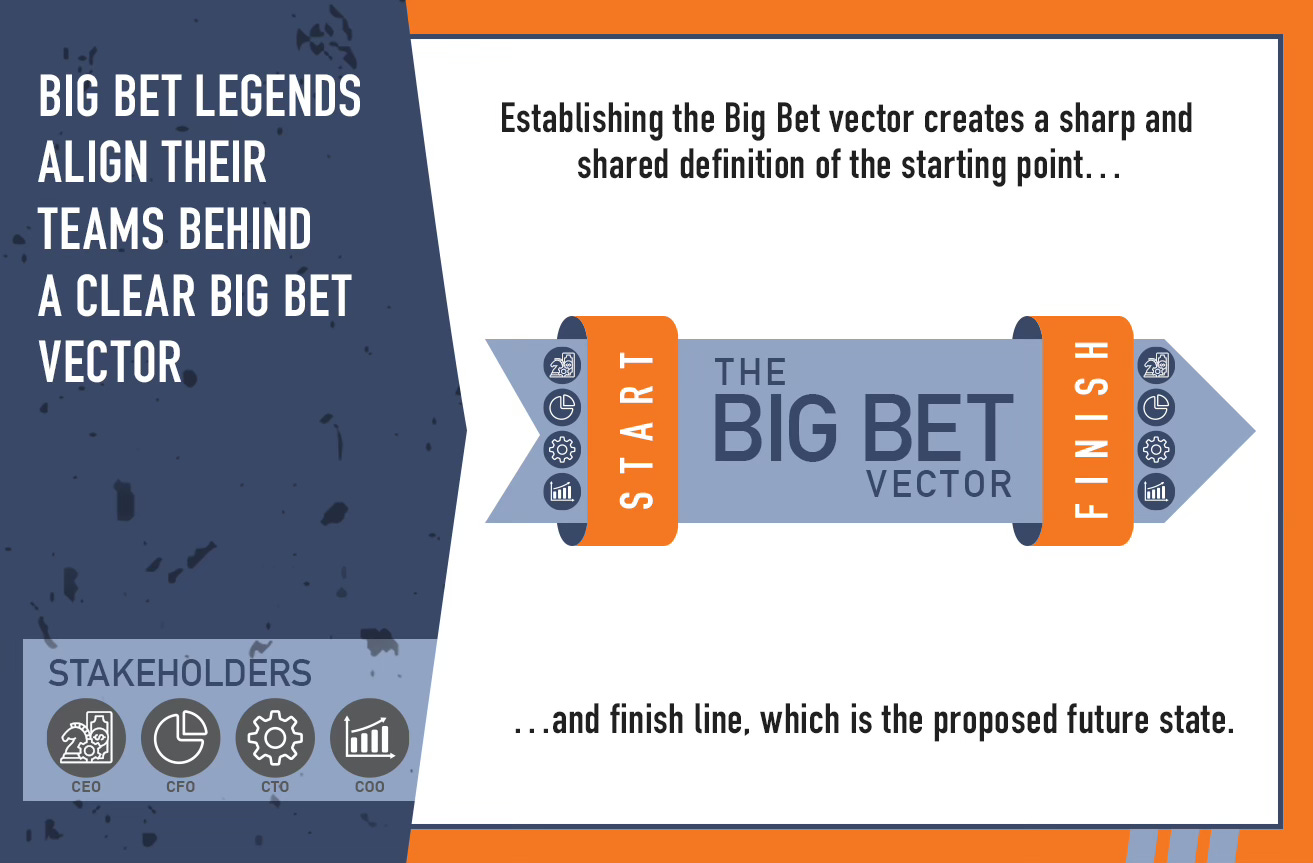You Don’t Have a Growth Problem. You Have a Growth System Problem.
You miss 100% of the shots you don’t take — Wayne Gretzky
In today’s volatile and hyper-digital environment, sustained growth isn’t just a strategy—it’s a survival imperative. Yet, most companies fail to grow consistently. That’s not due to a lack of effort, ambition, or intelligence, but because of an outdated playbook. The reality is clear: consistent and transformative growth requires Big Bets.
In the Big Bet Leadership, I describe a Big Bet as a major strategic initiative designed to tackle a wicked problem and deliver trajectory-changing results. These are not incremental changes. They are bold, high-stakes moves—technology platform shifts, innovation programs, operating model transformations, or go-to-market repositionings. And while Big Bets are risky, avoiding them is even riskier.
Even the Bossman has a growth system!
What Separates Growth Champions?
A recent study by HBR1 examined over 2,100 U.S. public companies to understand what separates growth champions—those with consistent year-over-year revenue gains—from the rest. The top quartile had impressive compound growth rates, but those with consistent performance (the "growth champions") achieved significantly higher valuations: 4.2x revenue, compared to 2.8x for episodic performers.
What made these champions different? They didn’t rely on flashes of brilliance. They engineered growth systems—integrated capabilities, aligned operating models, and clear value propositions. Their leaders knew that sustainable growth doesn’t come from short-term tactics like discounts or rushed innovation. It comes from disciplined, long-term thinking.
What’s a Growth System?
A system isn’t a collection of tools, decisions, or your CRM. A true system is built on a theory of success—a strategy— defining an architecture guiding how decisions are made, how priorities are maintained, and how feedback loops reinforce performance. This architecture, when effective, embodies what Richard Rumelt calls the kernel of good strategy: a clear diagnosis of the core challenge, a guiding policy for navigating that challenge, and a set of coherent actions to move forward.
When a system is grounded in this strategic kernel, it becomes more than operational—it becomes directional. It transforms chaos into clarity and turns ambition into coordinated, repeatable progress. Good systems aren’t flashy, but they’re foundational. They do the heavy lifting behind the scenes, quietly aligning people, data, and decisions so that growth doesn't rely on heroics or chance.
In organizations that scale, the system isn't an afterthought—it is the strategy. Coherent systems are built to solve problems, not just pursue goals. And when the kernel is strong, momentum becomes a natural outcome, not a lucky break. That’s the power of good strategy embedded in good systems: progress that compounds, resilience that scales and adapts to market response and reality.
Big Bet Leadership builds on this notion of good strategy — it recognizes the inherent risks, the “bet” per se, and works to both amplify the advantage, while experimenting and understanding the key challenges before commitments are made.
The Myth of Playing It Safe
McKinsey’s power curve analysis supports this insight.2 Studying nearly 2,500 companies globally, they found that making bold strategic moves—such as large-scale M&A, major capital investments, or rapid resource reallocation—was the strongest predictor of success. Companies that made at least one bold move were more than twice as likely to move up into the top quintile of performance. Make three, and your odds increase sixfold.
In contrast, companies that made no bold moves? They flatlined—or worse.
So why don’t more companies act boldly? Because boldness without clarity is reckless. And because traditional management wisdom rewards optimization, not innovation. Leaders are trained to fear failure, not embrace uncertainty. This is precisely where *Big Bet Leadership* comes in.
Order your copy of Big Bet Leadership today. Available in hard cover, ebook or a great audio book version.
The Big Bet Vector: A Better Approach
Big Bet Leadership starts with establishing a clear Big Bet Vector—a strategy with both direction and magnitude. It’s not just about motion; it’s about moving toward a defined outcome at speed. At the heart of the Big Bet Vector are the three critical habits of Big Bet Legends like Jeff Bezos, Elon Musk, and John Legere:
1. Create Clarity – Growth doesn’t happen in ambiguity. Clarity starts with obsessing over the customer and ruthlessly defining the outcome. What is the precise use case? What’s the killer feature? What are the operating imperatives that must be true for success?
2. Maintain Velocity – Too many initiatives die in analysis paralysis. Big Bet leaders know what needs to move fast and what can’t be rushed. They create cultures that favor early learning, experimentation, and decision-making over bureaucracy.
3. Prioritize Risk and Value – Not all work is created equal. Great leaders focus on the riskiest and most valuable aspects first. They delay or defer anything that isn’t critical to validating the Big Bet hypothesis.
These habits create the conditions for making bold, smart moves. They allow companies to pull the strategic levers identified by McKinsey—like investing in differentiation, reallocating resources quickly, and driving productivity—in a way that compounds over time.
Interested in learning about the Big Bet Growth System? A tailored approach based off Big Bet Leadership to design and implement your high-ambition growth system?
Designing a Growth System
Sustainable growth is not about heroics; it’s about systems. HBR identifies five components of a growth system:
1. A compelling customer outcome – This is your North Star. Leaders must define a clear, differentiated value proposition. Companies like Toast thrived by building restaurant-specific payment solutions—not generic tools, but precise outcomes.
2. Architected capabilities – Growth leaders don’t improvise. They design the capabilities they need—tech, talent, partnerships—like a blueprint for a skyscraper. IKEA’s growth system, for example, blends design, cost control, and customer insights to continuously deliver on its brand promise.
3. A unified operating model – Silos kill growth. Old operating models do not adapt to the demands of higher growth. These companies rethink how product, marketing, sales and distribution align around the customer journey and a growth mandate.
4. Execution discipline – Clear priorities, strong feedback loops, and a bias toward action. Growth champions obsess over tracking what matters, and knowing what doesn’t.
5. A leadership mindset – Leaders who think future-back and risk-forward. They don’t just react to trends—they anticipate, shape and take advantage of them.
Big Bets Are Strategic, Not Optional
Making a Big Bet isn’t an ego trip. It’s not about being flashy, fearless or reckless.
It’s about being systematic and intentional.
Big Bets require a clear hypotheses, rigorous experimentation, and alignment of resources. Done right, they don’t just create growth—they make it repeatable, seeking out maximum ambition while managing the downside risks.
This is how you break free from the cycle of episodic success and build an engine that delivers year after year.
The best companies, the growth champions, don’t ask, “Can we afford to place a Big Bet?” They ask, “Can we afford not to?”
Onward!
John
About The Digital Leader Newsletter
This is a newsletter for change agents, strategists, and innovators. The Digital Leader Newsletter is a weekly coaching session focusing on customer-centricity, innovation, and strategy. We deliver practical theory, examples, tools, and techniques to help you build better strategies, better plans, and better solutions — but most of all, to think and communicate better.
John Rossman is a keynote speaker and advisor on leadership and innovation. Learn more at www.johnrossman.com
HBR: Crete a System to Grow Consistently https://hbr.org/2024/03/create-a-system-to-grow-consistently
McKinsey: How to Make the Bold Strategy Moves that Matter: https://www.mckinsey.com/~/media/McKinsey/Business%20Functions/Strategy%20and%20Corporate%20Finance/Our%20Insights/How%20to%20make%20the%20bold%20strategy%20moves%20that%20matter/How-to-make-the-bold-strategy-moves-that-matter.ashx






